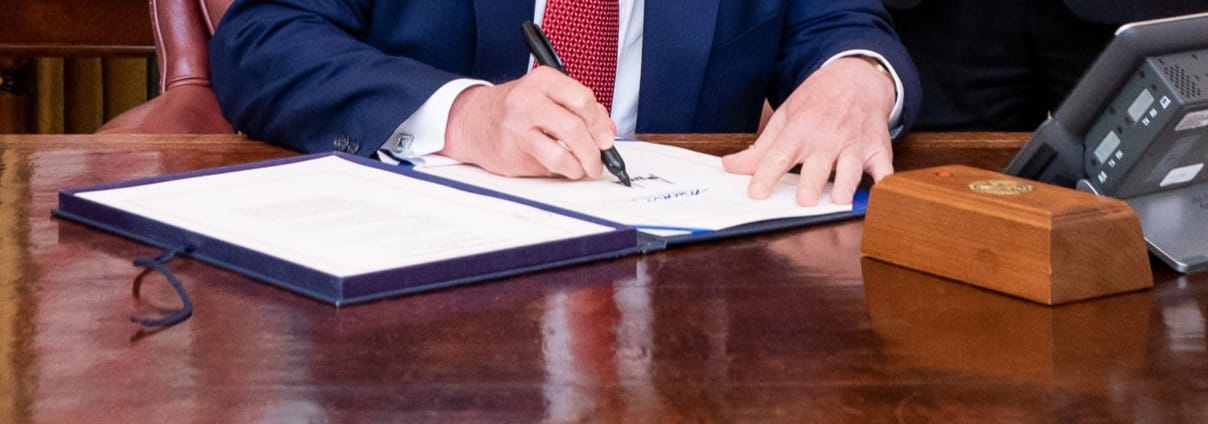Following the publication of this article, reports surfaced indicating that Republican appropriators in Congress belatedly sent the Pentagon funding tables detailing congressional intent for the Pentagon spending in the CR.
As DOGE and the White House continue their campaign to shift spending decisions from Congress to the Oval Office, Republicans in Congress are looking to do them a solid. The Continuing Resolution (CR) being debated this week not only boosts Pentagon spending, it gives the White House increased authority over how to spend these funds. With the White House increasingly pushing Congress to the sidelines on everything from trade policy, to how agencies interact with taxpayers, to whether whole agencies should even exist, it’s time for Congress to reassert its constitutional duty to manage the power of the purse.
As discussed in the last Weekly Wastebasket, continuing resolutions (CRs) are stop-gap spending bills that fund the government at the previous fiscal year’s levels. They are a product of Congress failing to do its job and pass appropriations bills before the start of a new fiscal year. CRs do prevent the government from shutting down, but they are disruptive and inefficient.
The Continuing Resolution passed by House Republicans this week would mark the first time the entire government has ever operated under a CR for the entire fiscal year. The closest we’ve gotten before was in fiscal year 2011 when all agencies except the Pentagon had to operate under a full-year CR. So, in a year of unprecedented happenings if you had that on your budget bingo card for 2025, you’re in luck.
But while this CR will force most agencies to operate at or below Fiscal Year 2024 spending levels and hold off on funding any new projects, it gives the Pentagon some special treatment.
Pentagon Hikes and Cuts
The bill would increase national security spending by $6 billion over FY 2024 levels, while cutting $13 billion in other spending. Within the Pentagon budget, the bill increased funding for Military Personnel and Operation and Maintenance (O&M) accounts, and reduced funding for Procurement and Research, Development, Test and Evaluation (RDT&E). Still, certain Procurement programs saw increases. For instance, the bill adds $3.8 billion over FY 2024 levels to the Navy’s Shipbuilding and Conversion accounts, which includes funding for a third Arleigh Burke-class Destroyer that was not included in the Pentagon’s FY 2025 budget request. And by the same token, while the bill boosts most O&M accounts, it cut the Army’s by $636 million.
New Starts
Typically, CRs do not allow government agencies to spend money on new starts, that is programs that were not funded in the previous fiscal year. But Section 1409 of the House CR allows new starts for any project or activity that was funded in the House and Senate versions of the FY 2025 Pentagon spending bills, which never became law. In other words, if Congress was considering new funding for a specific Pentagon project, the CR would allow the Pentagon to spend money on that project as long as it stays within the $892.5 billion national security spending topline set by the CR.
More Transfer Authority
The bill also increases the amount of funds the Pentagon can transfer between accounts in its budget to $8 billion, up from $6 billion in the previous CR. Thankfully, this means Congress rejected the White House’s request to QUINTUPLE the Pentagon’s transfer authority to $30 billion—indicating that it is not yet prepared to surrender that much of its budgeting power to the executive branch, that is if they stand their ground. However, the increase still underscores the expanding scope of special treatment afforded to the Pentagon in this CR.
Vastly More Line-Item Flexibility
Typically, the Pentagon appropriations bill is accompanied by a joint explanatory statement (JES) and funding tables that indicate congressional intent as to how the Pentagon should spend appropriated funds at the program element and project levels. But continuing resolutions are meant to be temporary fixes, so they do not come with JESs. And this year-long CR is no exception—it will simply appropriate funds at the account level (e.g. Aircraft Procurement, Air Force), with the exception of Navy Shipbuilding and Conversion, for which it lists appropriations at the program element level (e.g. Arleigh Burke Destroyer). It’s the culinary equivalent of choosing a restaurant and then ordering an unspecified appetizer, entree, and dessert leaving the details to the chef, or maybe the best friend/special advisor to the chef.
On the one hand, that means the Pentagon may decide against funding many of the 1,500 program increases Congress included in its funding tables accompanying the House and Senate Pentagon appropriations bills, which totaled $39 billion (though the new start authority means the administration could spend money on those increases if it wants). On the other hand, it also means the administration can spend money within each account as it sees fit unless otherwise specified in the bill, which is a rare if not unprecedented abdication of congressional authority over national security spending.
Bear in mind that Secretary of Defense Pete Hegseth has asked the military services to propose eight percent reductions to their FY26 spending plans in order to redirect that funding to Trump administration priorities within the Pentagon budget. It would not be surprising if the administration tries to get a head start on the reshuffling of priorities by using the flexibility of the full-year CR to rearrange funding within accounts, and using the transfer authority to rearrange funding between accounts. But unlike any spending shifts in the FY 2026 Pentagon budget request, shifts made during FY 2025 would not be subject to the standard procedures governing congressional oversight and approval of Pentagon spending.
What About Reconciliation?
While the full-year CR on the whole significantly restrains Pentagon spending increases for FY 2025 relative to Congress’ traditional spending sprees, Republican leadership in Congress is hoping to override that restraint through reconciliation, which under the House reconciliation plan would instruct the Armed Services Committees to add $100 billion to the Pentagon budget (the Senate plan included $150 billion). If the House reconciliation plan is adopted, whatever portion of that $100 billion the committees appropriate for FY 2025 would be added on top of the $6 billion Pentagon spending increase in the full-year CR.
Big picture—assuming both the full-year CR and reconciliation are passed and signed into law, both the administration and Congress will have ample opportunity to boost Pentagon spending on their priorities, and topline Pentagon spending will increase dramatically over the next two years. But the process for making these spending decisions will be less democratic than ever—the administration will be able to shuffle money around like never before with minimal congressional oversight, and Congress will use the highly partisan reconciliation process to make sure its priorities, or at least the priorities of the majority party, are fully funded. With the national debt exceeding $36 trillion and Pentagon spending on a glide path to $1 trillion per year, it’s a terribly irresponsible way to budget for national security.
- Photo by Giorgio Trovato on Unsplash










